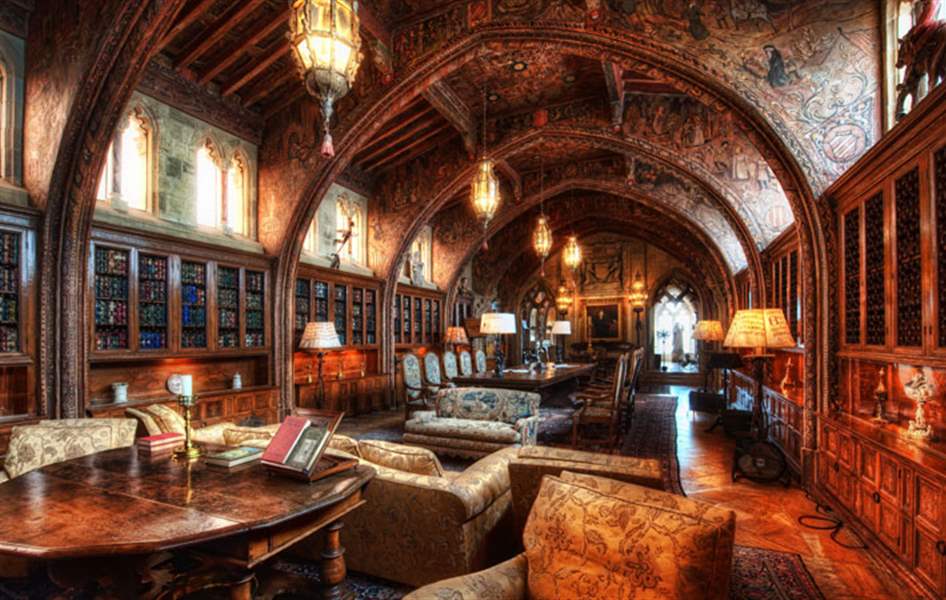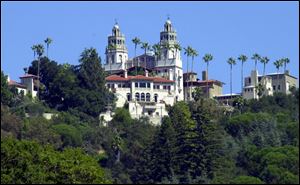
William Randolph Hearst lived like a king on his ‘Enchanted Hill’
3/23/2014
William Randolph Hearst conducted business in the Gothic Study of his mansion.
HEARSTCASTLE.ORG

Hearst Castle, the legendary home of publishing tycoon William Randolph Hearst, sits on a state-owned parcel within the 82,000-acre Hearst Ranch at San Simeon, Calif.
SAN SIMEON, Calif. — William Randolph Hearst knew only too well the constantly changing nature of business and politics. His media empire once dominated American opinion, and his political aspirations were set on the White House.
They all came to naught, but there was one place where he could always be king of the hill, one piece of earth he could mold into his grand design with nobody telling him he couldn’t.
“I love the sea and I love the mountains and the hollows in the hills and the shady places in the creeks and the fine old oaks and even the hot brushy hillsides — full of quail — and the canyons full of deer,” Hearst wrote shortly before construction began on his dream castle on the central California coast in 1920. “It’s a wonderful place. I would rather spend a month here than any place in the world.”
He called it “La Cuesta Encantada,” or “The Enchanted Hill.” His wealthy father, George Hearst, bought 40,000 acres midway between San Francisco and Los Angeles in the 19th century as a cattle ranch. His only child spent many happy hours camping and riding on the undeveloped property above the Pacific Ocean, and in 1919 with the death of his mother, the land — and $11 million — was all his.
The Hearst Corp., which at one time controlled the nation’s largest newspaper chain, still maintains a cattle herd on the land, but if you look closely, you’re sure to spot a few zebras mingling with the cows. More about that later.
The site is often called San Simeon after the old whaling village on California’s central coast at the base of a five-mile winding road that leads to its spectacular group of fairy-tale buildings and gardens. The view from the estate enhances the beauty of the scene, a picture-book image of the Pacific and the lacy mist that hangs below a piercingly blue sky.
Its official name now is Hearst Castle, run with a relaxed efficiency by the California State Parks system, which accepted the buildings and grounds as a donation from the corporation in 1957. It attracts about 700,000 visitors a year.
A guided tour lasts about an hour, including the bus ride from the visitor center across the highway from San Simeon, leaving plenty of time to explore the pleasant small towns along the coast or just inland. A longer ride toward Paso Robles, about 30 miles away, is dotted with dozens of vineyards with their tasting rooms.
My daughter and I made the four-hour ride from her Los Angeles home in January, a scenic journey along the coast-hugging Route 101, scenic that is, once you escape the L.A. traffic and roll past Santa Barbara with the Channel Islands looming in the distance. Fine views of the coast’s rocky beaches accompanied us most of the way north until we turned slightly inland, through the Gaviota Pass, and then up a long winding stretch. Leaving 101 toward San Simeon onto Route 1, the road shrunk to two lanes.
My interest in Hearst Castle began the first time I watched Orson Welles’ 1941 film Citizen Kane years ago — and many times since. Despite Welles’ coy denials, the famous movie was inspired by the excesses of Hearst, including his famous home. In one scene, the newspaper magnate Kane stands stiffly in the foreground while far in the background of an enormous room, his unhappy wife, Susan, works a jigsaw puzzle in front of a huge fireplace.
I saw the real fireplace that was re-created for the movie at the castle’s Assembly Room, and it looks even bigger in person. There are also a few jigsaw puzzles lying about. Just like Kane’s wife in the film, Hearst’s movie-star mistress Marion Davies loved to assemble them as well.

William Randolph Hearst conducted business in the Gothic Study of his mansion.
The photos of the estate found in the numerous biographies of Hearst are inadequate to capture the scale, craftsmanship, and attention to detail that its owner lavished on its construction. Hearst Castle rivals the grandeur of Versailles.
For a short time, it was also home to the world’s largest private zoo, which, like the Hearst Castle itself, was designed by San Francisco architect Julia Morgan, one of the few female professional architects practicing in the mid-20th century. The zebras and a sambar deer are all that remain from the zoo of more than 300 animals that closed in 1937 as the Depression took its toll on Hearst’s fortunes.
We took a seasonal tour for $30 each that emphasized the special collaboration between Hearst and Morgan, who translated the eclectic tastes and ever-changing whims of the estate’s owner, an undisciplined spoiled rich boy all his life.
Hearst was the world’s greatest shopper, purchasing large chunks of ancient Europe and Greece regardless of the price. This collection of statuary, tapestries, mantelpieces, elaborate ceilings, religious displays, and thousands of pieces of furniture was carefully incorporated into the 80,000 square feet of living space.
Led by a patient, informative guide, the tour ended at the Roman Pool, a stunning indoor facility tiled floor to ceiling in serene blue, gold, and yellow mosaics. This pool holds 205,000 gallons, slightly less than the 345,000 in the outdoor Neptune Pool. We were left to stroll the gardens at our own pace.
The center offers three tours year-around at $25: The Grand Rooms tour is the basic view of the Castle and includes the Assembly Room, the Refectory, a lavishly decorated dining room where Hearst held court in the middle of a magnificent table, the Theater showing first-run Hollywood films (but never Citizen Kane, allegedly) and the carefully tended gardens.
The Upstairs Suites tour covers the Doge’s Suite, modeled after rooms in Venice’s Doge’s Palace; the Library, an 80-foot-long chamber of 4,000 books; and the Gothic Suite, where Hearst and Davies had bedrooms.
Cottages and Kitchens moves from the sublime to the practical, taking in the three guest “cottages” of ornate decoration and comfort where such notables as Winston Churchill and George Bernard Shaw relaxed, to the large kitchens designed to serve hundreds of guests.
All three include the pools and gardens on 127 acres maintained by 300 full and part-time workers in the state park region.
Hearst spared no expense to be lord of the manor, perhaps half a billion dollars in today’s economy, an extravagance that drained his enormous wealth. From the 1920s to the outbreak of World War II, the Castle drew a steady stream of guests until Hearst’s poor health forced him to live with Davies in Beverly Hills, Calif., where he died in 1951. The family later deeded the Castle property to the state of California, retaining a large tract of land for ranching.
The Castle’s website presents a considerable amount of information and can book tours online: www.hearstcastle.org.
The Block News Alliance consists of The Blade and the Pittsburgh Post-Gazette. Bob Hoover is the retired book editor of the Post-Gazette.